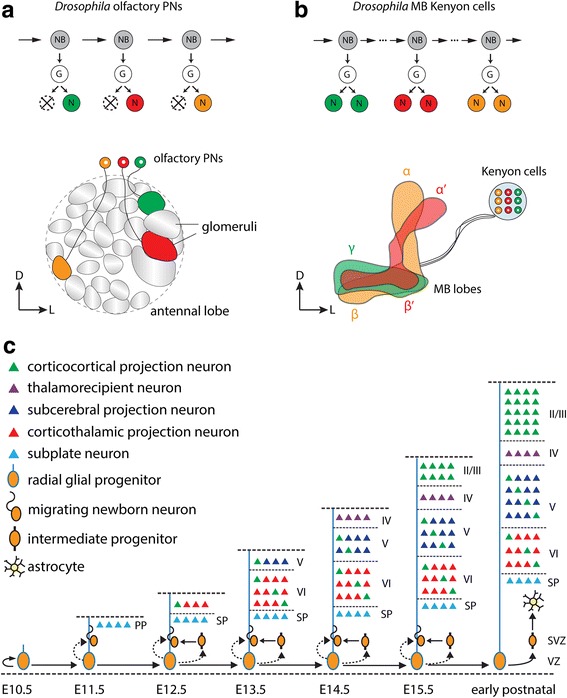Fig. 1.

Intrinsic regulation of birth timing-dependent neural wiring. a and b In Drosophila, different types of olfactory projection neurons (PNs; a) and mushroom body (MB) Kenyon cells (KCs; b) are sequentially born from a common neuroblast (NB) in a stereotyped manner. In the anterodorsal PN (adPN) lineage, one of the postmitotic neurons undergoes apoptosis, so that only one PN is generated from one ganglion mother cell (GMC; labeled as G). Different PN classes send their dendrites to specific regions (glomeruli) in the antennal lobe. In the KC lineage, both postmitotic neurons resulting from GMC division survive and project their axons to the same MB lobe. D: dorsal; L: lateral. c In the developing mouse cortex, radial glia in the ventricular zone (VZ) divide asymmetrically to give rise to newborn projection neurons that populate progressively more superficial layers of the mature cortex and intermediate progenitors in the subventricular zone (SVZ), which themselves further divide to generate newborn projections neurons. Corticocortical projection neurons in layers II/III and scattered throughout layers V and VI project within the cortex; subcerebral projection neurons primarily occupying layer V project to subcortical structures such as the superior colliculus, pons and spinal cord; and corticothalamic projection neurons primarily occupying layer VI project to the thalamus. Radial glia produce astrocytes last, after filling in the cortex with projection neurons. Arrows represent postmitotic progeny; arrows with dotted lines represent possible postmitotic progeny. SP: subplate; PP: preplate; EX (e.g. E13.5): embryonic day X (days post conception, e.g. embryonic day 13.5) in mouse
